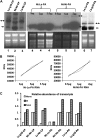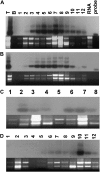The role of heterologous chloroplast sequence elements in transgene integration and expression
- PMID: 20130101
- PMCID: PMC2850035
- DOI: 10.1104/pp.109.152017
The role of heterologous chloroplast sequence elements in transgene integration and expression
Abstract
Heterologous regulatory elements and flanking sequences have been used in chloroplast transformation of several crop species, but their roles and mechanisms have not yet been investigated. Nucleotide sequence identity in the photosystem II protein D1 (psbA) upstream region is 59% across all taxa; similar variation was consistent across all genes and taxa examined. Secondary structure and predicted Gibbs free energy values of the psbA 5' untranslated region (UTR) among different families reflected this variation. Therefore, chloroplast transformation vectors were made for tobacco (Nicotiana tabacum) and lettuce (Lactuca sativa), with endogenous (Nt-Nt, Ls-Ls) or heterologous (Nt-Ls, Ls-Nt) psbA promoter, 5' UTR and 3' UTR, regulating expression of the anthrax protective antigen (PA) or human proinsulin (Pins) fused with the cholera toxin B-subunit (CTB). Unique lettuce flanking sequences were completely eliminated during homologous recombination in the transplastomic tobacco genomes but not unique tobacco sequences. Nt-Ls or Ls-Nt transplastomic lines showed reduction of 80% PA and 97% CTB-Pins expression when compared with endogenous psbA regulatory elements, which accumulated up to 29.6% total soluble protein PA and 72.0% total leaf protein CTB-Pins, 2-fold higher than Rubisco. Transgene transcripts were reduced by 84% in Ls-Nt-CTB-Pins and by 72% in Nt-Ls-PA lines. Transcripts containing endogenous 5' UTR were stabilized in nonpolysomal fractions. Stromal RNA-binding proteins were preferentially associated with endogenous psbA 5' UTR. A rapid and reproducible regeneration system was developed for lettuce commercial cultivars by optimizing plant growth regulators. These findings underscore the need for sequencing complete crop chloroplast genomes, utilization of endogenous regulatory elements and flanking sequences, as well as optimization of plant growth regulators for efficient chloroplast transformation.
Figures








Similar articles
-
Improved heterologous protein expression in the chloroplast of Chlamydomonas reinhardtii through promoter and 5' untranslated region optimization.Plant Biotechnol J. 2011 Aug;9(6):674-83. doi: 10.1111/j.1467-7652.2011.00620.x. Epub 2011 May 2. Plant Biotechnol J. 2011. PMID: 21535358
-
Bacteriophage 5' untranslated regions for control of plastid transgene expression.Planta. 2013 Feb;237(2):517-27. doi: 10.1007/s00425-012-1770-3. Epub 2012 Sep 30. Planta. 2013. PMID: 23053542
-
Expression of cholera toxin B-proinsulin fusion protein in lettuce and tobacco chloroplasts--oral administration protects against development of insulitis in non-obese diabetic mice.Plant Biotechnol J. 2007 Jul;5(4):495-510. doi: 10.1111/j.1467-7652.2007.00259.x. Epub 2007 May 9. Plant Biotechnol J. 2007. PMID: 17490448 Free PMC article.
-
Comparison of effectiveness of 5'-regulatory sequences in transplastomic tobacco chloroplasts.Transgenic Res. 2017 Feb;26(1):65-75. doi: 10.1007/s11248-016-9980-2. Epub 2016 Aug 26. Transgenic Res. 2017. PMID: 27565642
-
Recent achievements obtained by chloroplast transformation.Plant Methods. 2017 Apr 19;13:30. doi: 10.1186/s13007-017-0179-1. eCollection 2017. Plant Methods. 2017. PMID: 28428810 Free PMC article. Review.
Cited by
-
Oral delivery of therapeutic proteins bioencapsulated in plant cells: preclinical and clinical advances.Curr Opin Colloid Interface Sci. 2021 Aug;54:101452. doi: 10.1016/j.cocis.2021.101452. Epub 2021 Mar 24. Curr Opin Colloid Interface Sci. 2021. PMID: 33967586 Free PMC article.
-
Metallothionein expression in chloroplasts enhances mercury accumulation and phytoremediation capability.Plant Biotechnol J. 2011 Jun;9(5):609-17. doi: 10.1111/j.1467-7652.2011.00616.x. Epub 2011 Apr 24. Plant Biotechnol J. 2011. PMID: 21518240 Free PMC article.
-
Effect of chronic administration with human thioredoxin-1 transplastomic lettuce on diabetic mice.Food Sci Nutr. 2021 Jun 21;9(8):4232-4242. doi: 10.1002/fsn3.2391. eCollection 2021 Aug. Food Sci Nutr. 2021. PMID: 34401074 Free PMC article.
-
Elucidation of Nuclear and Organellar Genomes of Gossypium hirsutum: Furthering Studies of Species Evolution and Applications for Crop Improvement.Biology (Basel). 2013 Oct 18;2(4):1224-41. doi: 10.3390/biology2041224. Biology (Basel). 2013. PMID: 24833222 Free PMC article.
-
Platforms for Production of Protein-Based Vaccines: From Classical to Next-Generation Strategies.Biomolecules. 2021 Jul 21;11(8):1072. doi: 10.3390/biom11081072. Biomolecules. 2021. PMID: 34439738 Free PMC article. Review.
References
-
- Bock R. (2007) Plastid biotechnology: prospects for herbicide and insect resistance, metabolic engineering and molecular farming. Curr Opin Biotechnol 18: 100–106 - PubMed
Publication types
MeSH terms
Substances
Grants and funding
LinkOut - more resources
Full Text Sources
Other Literature Sources
Research Materials

